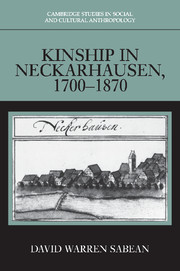Book contents
- Frontmatter
- Contents
- List of tables
- Abbreviations
- Abbreviations of sources
- On reading kinship diagrams
- Glossary
- Preface
- Introduction
- Cohort I (1700–1709)
- Cohort II (1740–1749)
- Cohort III (1780–1789)
- Cohort IV (1820–1829)
- Cohort V (1860–1869)
- Conclusion
- Appendix
- Bibliography
- General index
- Index of villagers
Appendix
Published online by Cambridge University Press: 04 August 2010
- Frontmatter
- Contents
- List of tables
- Abbreviations
- Abbreviations of sources
- On reading kinship diagrams
- Glossary
- Preface
- Introduction
- Cohort I (1700–1709)
- Cohort II (1740–1749)
- Cohort III (1780–1789)
- Cohort IV (1820–1829)
- Cohort V (1860–1869)
- Conclusion
- Appendix
- Bibliography
- General index
- Index of villagers
Summary
Construction of genealogies
A systematic study of kinship networks cannot proceed without genealogical information. That information must be broad enough to test the limits of genealogical knowledge and practice. It is common enough for people in primitive or “traditional” societies to have a considerable genealogical memory and to be able to locate most of their acquaintances somewhere on its coordinates. The methodological difficulty arises as soon as one wants to study more than a handful of people, for constructing a genealogy is a time-consuming, complex business. Theoretically, at least, its dimensions can be overwhelming. Assume, for example, a family size of four children who eventually marry. Tracing back three generations from an individual and then forward one generation beyond him or her would produce a genealogy well in excess of 4,000 individuals. To carry out the same exercise for the marriage partner would, of course, double the number of people traced. In actual fact, genealogies constructed on the basis of Neckarhausen records are never of this size, although the longest by far that I have constructed for a married couple has between 1,500 and 2,000 individuals in it. A typical long genealogy has 700–900, the average around 500–600. Genealogies of this dimension include those children who died young or who never married. Tracing just individuals who attained adulthood or who can be shown to have married reduces the size considerably, although not the complexity.
- Type
- Chapter
- Information
- Kinship in Neckarhausen, 1700–1870 , pp. 511 - 590Publisher: Cambridge University PressPrint publication year: 1997



